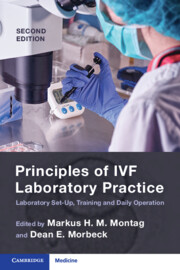Book contents
- Principles of IVF Laboratory Practice
- Principles of IVF Laboratory Practice
- Copyright page
- Contents
- Contributors
- Foreword
- The Evolution of IVF Practice
- Section 1 Starting a New Laboratory and Training Protocols
- Chapter 1 Establishing and Equipping a New IVF Laboratory
- Chapter 2 Basic Embryology Skills and Responsibilities in the IVF Laboratory
- Chapter 3 Sperm Preparation for IVF
- Chapter 4 Oocyte Pick-Up for IVF
- Chapter 5 Embryologist Training: Embryo Transfer
- Chapter 6 ICSI for IVF
- Chapter 7 Embryo Assisted Hatching for IVF
- Chapter 8 Embryo Biopsy for IVF
- Chapter 9 Vitrification for IVF
- Section 2 Pre-procedure Protocols
- Section 3 Gametes
- Section 4 Insemination/ICSI
- Section 5 Fertilization Assessment
- Section 6 Embryo Assessment: Morphology and Beyond
- Section 7 Embryo Cryopreservation
- Section 8 Embryo Transfer
- Section 9 Quality Management
- Index
- References
Chapter 9 - Vitrification for IVF
Training Protocol
from Section 1 - Starting a New Laboratory and Training Protocols
Published online by Cambridge University Press: 07 August 2023
- Principles of IVF Laboratory Practice
- Principles of IVF Laboratory Practice
- Copyright page
- Contents
- Contributors
- Foreword
- The Evolution of IVF Practice
- Section 1 Starting a New Laboratory and Training Protocols
- Chapter 1 Establishing and Equipping a New IVF Laboratory
- Chapter 2 Basic Embryology Skills and Responsibilities in the IVF Laboratory
- Chapter 3 Sperm Preparation for IVF
- Chapter 4 Oocyte Pick-Up for IVF
- Chapter 5 Embryologist Training: Embryo Transfer
- Chapter 6 ICSI for IVF
- Chapter 7 Embryo Assisted Hatching for IVF
- Chapter 8 Embryo Biopsy for IVF
- Chapter 9 Vitrification for IVF
- Section 2 Pre-procedure Protocols
- Section 3 Gametes
- Section 4 Insemination/ICSI
- Section 5 Fertilization Assessment
- Section 6 Embryo Assessment: Morphology and Beyond
- Section 7 Embryo Cryopreservation
- Section 8 Embryo Transfer
- Section 9 Quality Management
- Index
- References
Summary
In recent years, reliable aseptic closed vitrification systems have been accepted instead of open devices and have changed the ART-cryopreservation landscape in the combat against any microbiological exposure. Still, misunderstanding on the balances in a vitrification method and inappropriate implementations expose IVF laboratories to inconsistent survival and pregnancy outcomes. The present set-up and training of a microdroplet vitrification model for human blastocysts takes into account some important quality-control factors to minimize technical variation with consistent good laboratory practice. A uniform approach of the physical environment at 37 °C was validated with a ready-to-use DMSO free vitrification kit plus Ssucrose warming kit and a closed storage device with a hole carrier, based on optimal visualization, simplicity of loading/recovery, consistent volumes and ionomeric-resin straws with secured seals. The microdroplet closed vitrification model offers safety, reliability, consistency with successful results towards benchmark survival / transfer rates (>95%) and promising day 5 vitrified blastocyst live birth rates (>30%).
Keywords
- Type
- Chapter
- Information
- Principles of IVF Laboratory PracticeLaboratory Set-Up, Training and Daily Operation, pp. 65 - 74Publisher: Cambridge University PressPrint publication year: 2023
References
- 1
- Cited by

